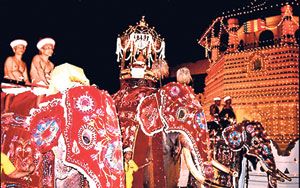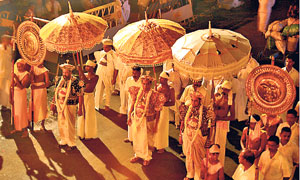With the dawn of the month of August, the focus shifts from deep-south Sri Lanka to the central hills. It's the month of the Esala Festival in Kandy where the annual perahera is held, watched by thousands of devotees. Foreign tourists also flock to the hill capital to see the most elaborate pageant.
The preliminaries for this year's Esala Perahera begins on August 10 with the 'kap situvima' or the installation of the 'kap' in each devale. Although in the early days, an 'asala' plant was selected for this purpose, it has been changed to a young jak tree which has not borne fruit. The plant is brought to the devale premises and
planted at the appointed time.
After the 'kap situvima', a mini perahera is held within the devale premises for five days. Known as the 'Devale Perahera', it is
conducted in the four devales situated in the vicinity of the Sri Dalada Maligawa dedicated to guardian deities, Natha, Vishnu, Kataragama and Pattini. The insignia of the
respective deity known as 'ranayudha' is taken in the procession to the
accompaniment of music and drumming along with flag and canopy bearers. The procession goes round the tree planted at the
'kap situvima'.
On Sunday August 15, the next stage will begin with the Kumbal Perahera which is also not an
elaborate procession and is confined to the devale premises.
On the sixth night of the Kumbal Perahera, begins the Randoli Perahera when the devale processions are joined by the Dalada Maligawa Perahera and it parades the streets of Kandy. The Randoli Perahera to be held from Friday August 20 until Tuesday August 24, will take different routes on the five days.
Palanquins
('randoli') containing the ornaments of goddesses, sword and pitcher of each devale are carried at the end of the Perahera – hence the name.
The Diyawadana Nilame, lay custodian of the Sacred Tooth Relic and the Basnayaka Nilames, chief lay officials of the devales, march in the Randoli Perahera in their traditional dress. All the other officials also wear the white dress designed to suit their title.
Being the most
glamorous procession, each night the number of
elephants in the Perahera is increased, making the Perahera bigger, grander and more colourful. The numerous dance groups, most of them belonging to families performing that ritual over many
generations, put out their best during the Randoli Perahera.
On the full moon day which falls on the last day of the Randoli Perahera about half an hour after its break up, the Perahera reassembles and makes its way to the Asgiriya Vihara, where the casket is placed. The devale peraheras return to their respective devales.
At dawn the following day, the four devale
peraheras bearing the insignia and the 'randoli', make their way to the water-cutting site at Getambe. At the river, the 'kapuralas' of the four devales, are led to some distance in the river, where each 'kapurala' cleaves the water with a sword and
collects a pitcher full, at the place where the sword touched the water, to be stored in the respective devales for one year, and fed back into the river, at a similar ceremony in the
following year.
In the early days of the Kandyan kingdom, the Esala Festival was given much prominence, with the four 'devale peraheras'.
The merger of these with the Dalada Perahera
(carrying the casket where the Sacred Tooth Relic is housed), took place during the reign of the King Kirti Sri Rajasinha (1747–1780), when the monks from Siam (now Thailand), came to Sri Lanka, to restore 'Upasampada' – the higher ordination of a monk, on the invitation of the king.
When the Thai monks, hearing the unusual noise of the musical instruments, inquired from the king as to what was going on, he explained that the devales were having their annual
procession. The monks then suggested that the Maligawa – the abode of the Tooth Relic – should take precedence over the devales and since that day, the Kandy Esala Pageant
giving pride of place to the Maligawa Perahera is held in the present form. |



